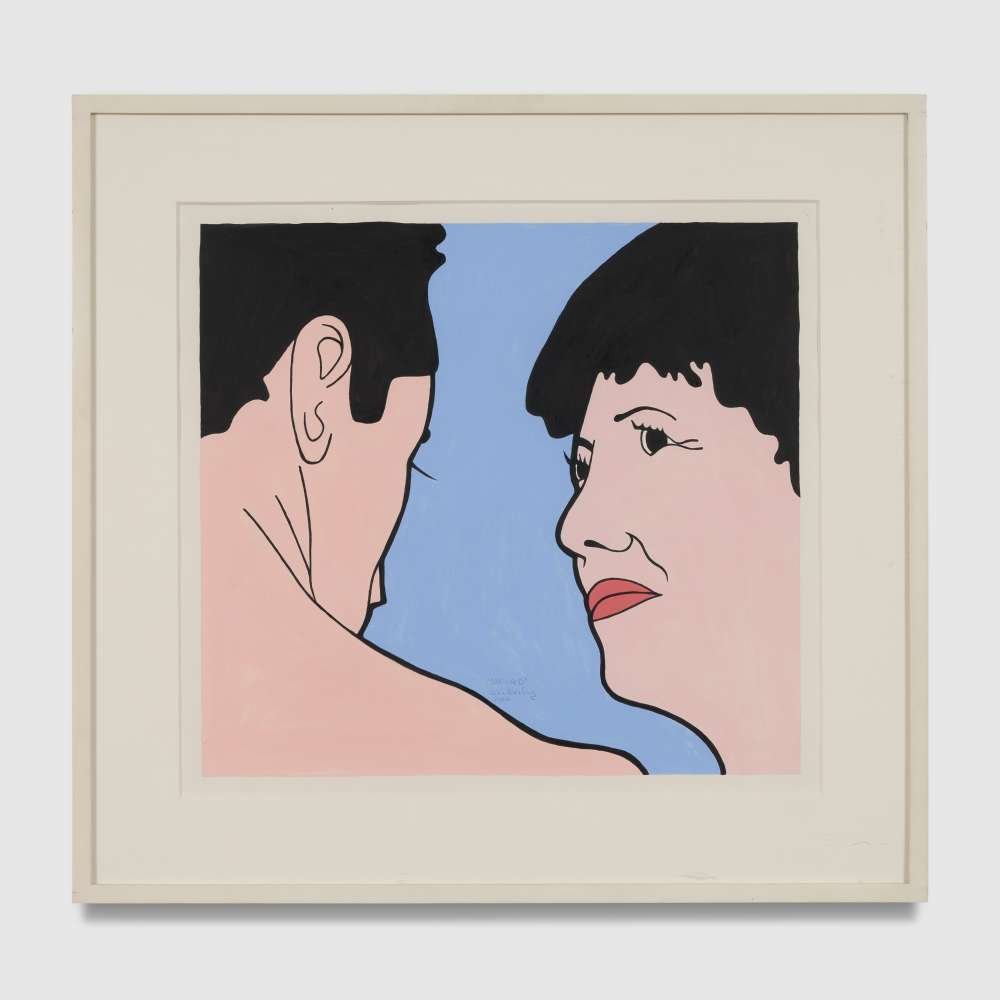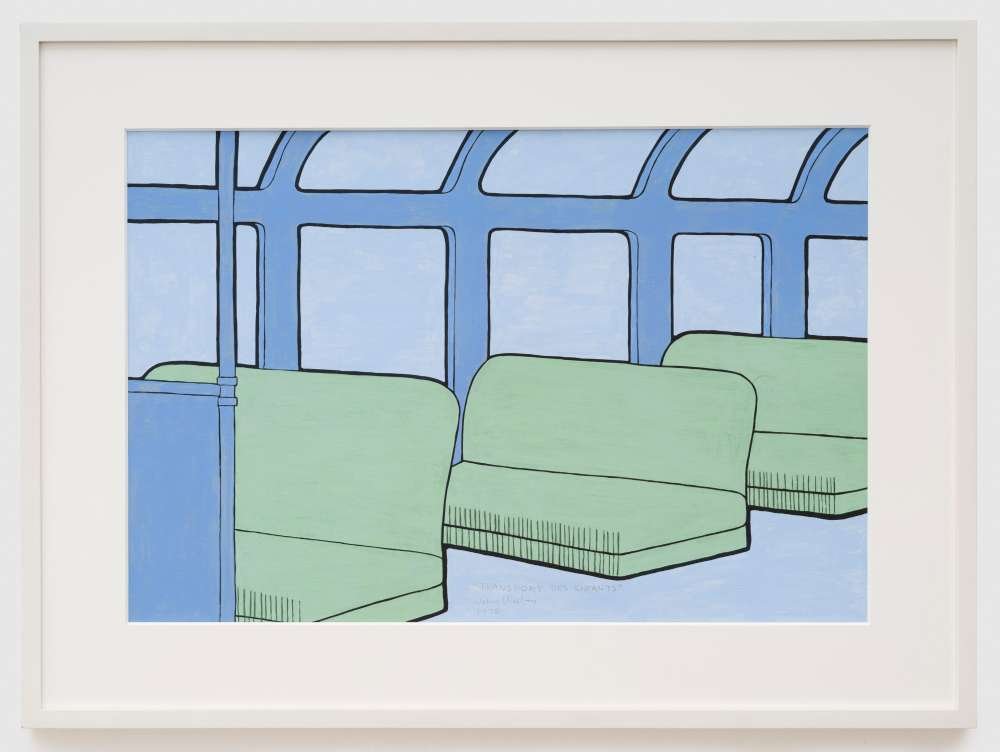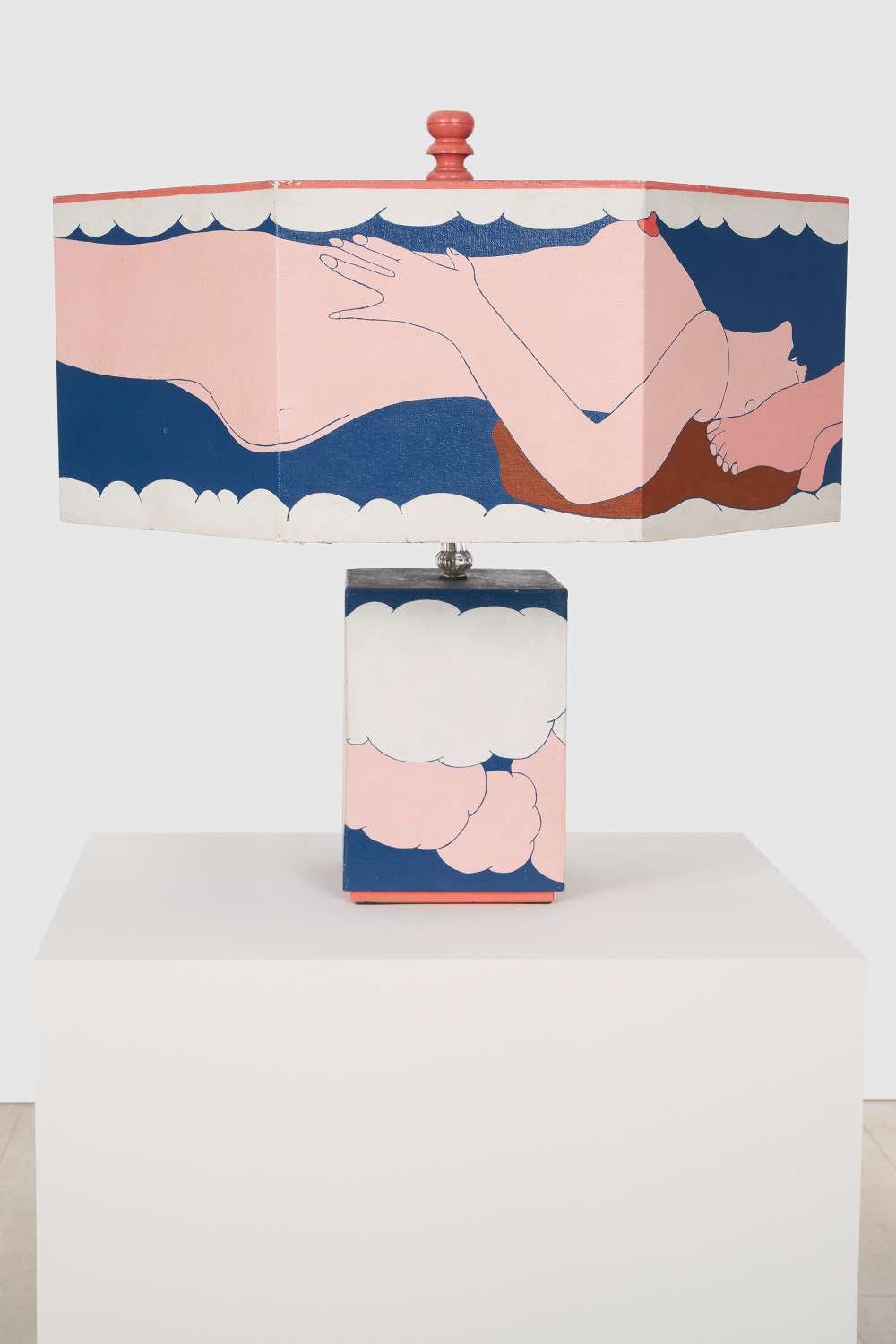WesleyWorld: Works on Paper and Objects 1961–2004
WesleyWorld: Works on Paper and Objects 1961–2004 540 West 25th Street, New York, NY 10001 January 12 – February 24, 2024 Photography courtesy Pace Gallery
New York – Pace Gallery is pleased to present its first exhibition dedicated to the work of John Wesley since the gallery began representing his estate in early 2023. The exhibit has been on view since January 12 and will close on February 24, 2024. Held at Pace’s New York location at 540 West 25th Street in New York, this exhibition brings together over 30 works on paper and painted objects produced by Wesley over the course of his career, from the early 1960s to the early 2000s.
Wesley, who died in 2022 at age 93, is known for his flattened, idiosyncratic figurations that defy easy classification within any single artistic movement. Drawing inspiration from images in comics and other mass media, the artist cultivated a distinctive, graphic style characterized by bold, weighted lines, unmodulated color, and an absurdist- edge.
Concord, 2004 WORK ON PAPER acrylic on paper 18" × 19-3/8" (45.7 cm × 49.2 cm), image 26-5/16" × 27-1/16" × 1-1/2" (66.8 cm × 68.7 cm × 3.8 cm), framed No. 89803 © John Wesley, courtesy of The John Wesley Foundation and Pace Gallery
Marked by eroticism, wry humor, and often a slight sense of unease, Wesley’s work explores a wide range of imagery informed by pop cultural and literary sources as well as the artist’s own memories and daily experiences. Many of his works are concerned with enactments of balance and symmetry, examining nuances of sexuality and desire through a formal language characterized by unexpected crispness and precision.
Untitled (Ducks), 1983 WORK ON PAPER acrylic on paper 39-1/2" × 62-1/2" × 1-1/2" (100.3 cm × 158.8 cm × 3.8 cm), framed No. 86524 © John Wesley, courtesy of The John Wesley Foundation and Pace Gallery
“The puzzling, open-ended ambiguity of Wesley’s depictions encourages expansive gestures of critique, whatever their ultimate merits,” art historian Richard Shiff writes in a newly commissioned essay for Pace Publishing’s digital catalogue accompanying the gallery’s Wesley exhibition. “To a theorist, his art readily demonstrates that interpretation has no limits, for every nuance of graphic difference initiates multiple interpretive threads with the potential to lead just about anywhere.”
Wesley produced a large body of landscapes regularly depicting tranquil shorelines and stormy seascapes, but also rolling hills and urban skylines. In his figurations, the human body and its constituent parts are often used to experiment with repetition as a formal device. Wesley also frequently reimagined characters from popular culture— most notably Dagwood Bumstead and his wife Blondie from the Blondie comic strip—in scenes across his body of work.
“His often caustic wit also has a warm-heartedness to it when the topic demands, and his sense of comedy is no less pronounced than his sense of tragedy,” art historian Martin Hentschel wrote in his 2005 publication on Wesley’s works on paper, continuing later, “He directed his gaze above all to the human condition, with all its peaks, ambiguities, and abysses.”















WesleyWorld: Works on Paper and Objects 1961–2004 540 West 25th Street, New York, NY 10001 January 12 – February 24, 2024 Photography courtesy Pace Gallery
Pace’s exhibition showcases the varied scales of Wesley’s works on paper, allowing visitors to experience the impressive range of form and imagery through which he experimented with repeating, layering, and mirroring—formal mainstays of his paintings. Though the works on view in the show span Wesley’s career, they reveal a remarkable consistency in his approach to image-making over the course of five decades. Tracing the evolution of the artist’s interests over time, these artworks shed light on the different subjects that entered his visual lexicon between the 1960s and 2000s.
Transport des Enfant, 1978 WORK ON PAPER acrylic on paper 19-3/4" × 25-1/2" (50.2 cm × 64.8 cm), paper No. 86528 © John Wesley, courtesy of The John Wesley Foundation and Pace Gallery
The show takes a broad view of Wesley’s life and career, spotlighting several objects by the artist—including a canvas vest and a selection of paper neckties—in addition to his works on paper. These rarely exhibited and, in some cases, never-before-exhibited pieces feature patterns and motifs that are often mirrored in the artist’s works on paper and paintings, reflecting his ability to translate his signature style across mediums and dimensions.
A unique voice in the canon of Contemporary art, John Wesley (b. 1928, Los Angeles, California; d. 2022, New York) is known for his precise, lyrical, and often deadpan painterly investigations of the American subconscious. With no formal artistic training, two of Wesley’s jobs had a direct impact on his early practice. At the age of 24, he began working as an illustrator in the Production Engineering Department at Northrop Aircraft in Los Angeles where he translated blueprints into drawings. In 1960, he moved to New York, where he worked as a postal clerk, utilizing symbols such as the shield-like postage stamp and his employee badge in his paintings. Later, his practice expanded to incorporate varied and enigmatic iconographies such as animals, beguiling women, and portraiture of subjects including Theodore Roosevelt, Rudyard Kipling, and Count Henri de Baillet-Latour, the president of the 1932 International Olympic Committee. Through a carefully refined visual vocabulary of clean lines, solid shapes, and repetition, Wesley imbued everyday scenes and quotidian subjects with humor and wry wit. Exploring themes relating to trauma, eroticism, innocence, and coyness, paintings within his oeuvre are characterized by a linear stylized formation, similar to comic strips, and are often populated with cartoon characters such as Dagwood Bumstead, Popeye, and Olive Oyl. His series, Searching for Bumstead, which he began in 1974 and continued for the entirety of his career, depicts empty interiors—including a vacant armchair, slippers by a bedside, a bathtub filled with water—and is an exploration of the trauma of losing his father, whose sudden death deeply affected him.
I'll Dream you in My Sees, ca. 1965 SCULPTURE duco and oil on canvas on found object (wood lamp) 31" × 29-1/2" × 29-1/2" (78.7 cm ×74.9cm×74.9cm) No. 86556 © John Wesley, courtesy of The John Wesley Foundation and Pace Gallery
Wesley defies categorization as an artist. During the 1960s, as the tenets of Pop art began to take shape, he was grouped with the movement due to the basic elements of his style and subject matter. Wesley exhibited alongside Pop artists such as Andy Warhol, Tom Wesselman, and Roy Lichtenstein but ultimately eluded true categorization both in theory and in practice due to his unique visual language. His first solo exhibition was at the Robert Elkon Gallery, New York, in 1963. Minimalist artist Donald Judd, a lifelong supporter of the artist, reviewed the paintings in the show: “the forms selected and shapes to which they are unobtrusively altered, the order used, and the small details are humorous and goofy. This becomes a cool, psychological oddness.” [1] Wesley was given his own room at the Documenta 5 Retrospective at Kassel (1972) and by the mid 70s it became clear that his work lay somewhere between Pop, Surrealism, and Minimalism, though no label ever encapsulated his singular style. Wesley’s contributions to painting are undeniable. Envisioned by Donald Judd, the largest collection of works by Wesley, spanning from 1963 to the present, are permanently on view in his eponymous gallery at the Chinati Foundation, Marfa, Texas. His work is held in public collections worldwide including the Hirshhorn Museum and Sculpture Garden, Washington D.C.; Kunstmuseum, Basel; The Museum of Modern Art, New York; Speed Art Museum, Louisville, Kentucky; and the Whitney Museum of American Art, New York, among others.
NECKTIES, 1981 SCULPTURE 66" × 22-1/2" × 1-5/8" (167.6 cm ×57.2cm×4.1cm) No. 88989 © John Wesley, courtesy of The John Wesley Foundation and Pace Gallery
Pace is a leading international art gallery representing some of the most influential contemporary artists and estates from the past century, holding decades-long relationships with Alexander Calder, Jean Dubuffet, Barbara Hepworth, Agnes Martin, Louise Nevelson, and Mark Rothko. Pace enjoys a unique U.S. heritage spanning East and West coasts through its early support of artists central to the Abstract Expressionist and Light and Space movements.
Since its founding by Arne Glimcher in 1960, Pace has developed a distinguished legacy as an artist-first gallery that mounts seminal historical and contemporary exhibitions. Under the current leadership of CEO Marc Glimcher, Pace continues to support its artists and share their visionary work with audiences worldwide by remaining at the forefront of innovation. Now in its seventh decade, the gallery advances its mission through a robust global program— comprising exhibitions, artist projects, public installations, institutional collaborations, performances, and interdisciplinary projects. Pace has a legacy in art bookmaking and has published over five hundred titles in close collaboration with artists, with a focus on original scholarship and on introducing new voices to the art historical canon.
Today, Pace has seven locations worldwide, including European footholds in London and Geneva as well as Berlin, where the gallery established an office in 2023. Pace maintains two galleries in New York—its headquarters at 540 West 25th Street, which welcomed almost 120,000 visitors and programmed 20 shows in its first six months, and an adjacent 8,000 sq. ft. exhibition space at 510 West 25th Street. Pace’s long and pioneering history in California includes a gallery in Palo Alto, which was open from 2016 to 2022. Pace’s engagement with Silicon Valley’s technology industry has had a lasting impact on the gallery at a global level, accelerating its initiatives connecting art and technology as well as its work with experiential artists. Pace consolidated its West Coast activity through its flagship in Los Angeles, which opened in 2022. Pace was one of the first international galleries to establish outposts in Asia, where it operates permanent gallery spaces in Hong Kong and Seoul, along with an office and viewing room in Beijing. In spring 2024, Pace will open its first gallery space in Japan in Tokyo’s new Azabudai Hills development.
For more information about this exhibition and others, please visit the Pace Gallery’s website here. Pace Gallery can be found on Instagram and Artsy, too.





